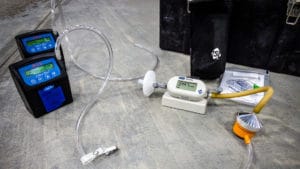Find an office location
More than 175 offices from coast to coast.

In 1936, a Congressional subcommittee published its findings regarding the Hawk’s Nest incident. While the report included a strong indictment of the builders of the tunnel, no further actions were undertaken. Fortunately, publicity regarding the incident did shape opinions, and by the close of 1937, all but two of the then 48 states had enacted laws benefiting workers with silicosis. While these measures constituted steps in the right direction, they were not preventative in nature. Such critical employer requirements would not be enacted for another 80 years.

In March 2016, the Occupational Safety and Health Administration (OSHA) issued a final rule to protect workers from exposure to respirable crystalline silica. The silica rule is comprised of two separate standards. The first (29 CFR 1926.1153) is known as the Silica Construction Standard, and applies to work within the construction industry including construction, demolition, alterations, repair, bridge erection, roadwork, excavations, large-scale painting projects, etc. The second (29 CFR 1910.1053) is known as the General Industry & Maritime Standard, and applies to work within the manufacturing (static in nature) and shipyard industries.
Crystalline Silica Rule: Quick Reference Table |
||
| Construction Standard29 CFR 1926.1153 | General Industry & Maritime Standard29 CFR 1910.1053 | |
| When Does Exposure Typically Occur? | During common construction tasks such as using masonry saws, grinders, drills, jackhammers, and handheld powered chipping tools; operating vehicle-mounted drilling rigs; milling; operating crushing machines; and using heavy equipment for demolition or certain other tasks. | During the manufacture of glass, pottery, ceramic, brick, concrete, asphalt roofing, jewelry, artificial stone, dental, porcelain, or structural clay products;While using industrial sand in operations such as foundry work and hydraulic fracturing;While using sand for abrasive blasting (e.g., maritime operations). |
| What Does the Standard Require Employers to Do? | 1. Limit worker exposures to respirable crystalline silica and to take other steps to protect workers;2. Either employ a control method prescribed within the standard or measure workers’ exposure and choose those dust control measures that will limit exposures to the PEL;3. Establish and implement a written exposure control plan;4. Designate a competent person to implement the written exposure control plan;5. Restrict housekeeping practices that expose workers to silica where feasible alternatives are available;6. Offer medical exams—including chest X-rays and lung function tests—every three years for workers who are required by the standard to wear a respirator for 30 or more days per year;7. Train workers regarding work operations that result in silica exposure and ways to limit exposure;8. Keep records of workers’ silica exposure and medical exams. | 1. Determine the concentration of silica to which workers are exposed, if the concentration may reasonably be expected to reach the Action Level (AL);2. Protect workers from exposures above the Permissible Exposure Limit (PEL);3. Establish and implement a written exposure control plan;4. Limit access to areas where workers could be exposed above the PEL;5. Use dust controls and safer work methods to protect workers for exposures above the PEL;6. Provide respirators to workers when dust controls and safer work methods cannot limit exposures to the PEL;7. Restrict housekeeping practices that might lead to exposure;8. Offer medical exams every three years to workers exposed at or above the AL for 30 days or more per year;9. Train workers regarding adverse health effects from exposure, work operations that result in silica exposure, and ways to limit exposure;10. Keep records of workers’ silica exposure and medical exams. |
| When Did the Requirements Go into Effect? | Construction employers must comply with all requirements of the standard by June 23, 2017, except requirements for laboratory evaluation of exposure samples, which begin on June 23, 2018. | General industry and maritime employers must comply with all requirements of the standard by June 23, 2018, with limited exceptions. |
| Action Level (AL) = 25 µg/m3 as an 8 hour time weighted average. | ||
| Permissible Exposure Limit (PEL) = 50 µg/m3 as an 8 hour time weighted average. | ||
OSHA estimates that 2.3 million workers in the United States are routinely exposed to respirable crystalline silica, the vast majority in the construction industry. Of these, OSHA estimates more than 640,000 are being exposed to concentrations that exceed the PEL. When compared to other regulated hazardous substances crystalline silica has an alarming rate of positive exposure assessments.

Help us help you protect your employees and achieve complete compliance. Non-compliance is not an option.
More than 175 offices from coast to coast.